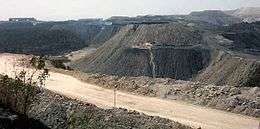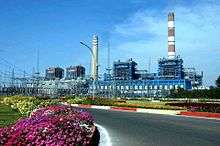Singrauli
| Singrauli सिंगरौली | |
|---|---|
| City | |
| Nickname(s): Energy capital of India | |
 Singrauli Location in Madhya Pradesh, India | |
| Coordinates: 24°12′07″N 82°39′58″E / 24.202°N 82.666°ECoordinates: 24°12′07″N 82°39′58″E / 24.202°N 82.666°E | |
| Country |
|
| State | Madhya Pradesh |
| District | Singrauli (Waidhan) |
| District Headquarter | Waidhan वैढ़न |
| Commissionaire/Division | Rewa रीवा |
| Government | |
| • Type | municipal |
| Area | |
| • Total | 2,200 km2 (800 sq mi) |
| Languages | |
| • Official | Hindi, Bagheli, English |
| Time zone | IST (UTC+5:30) |
| PIN | 486886 |
| Telephone code | 07805 |
| Vehicle registration | MP-66 |
| Website |
www |
Singrauli is a city in Singrauli district in the Indian state of Madhya Pradesh and Commissionaire of Rewa .
History
The area in the eastern part of the state of Madhya Pradesh and the adjoining southern part of Sonebhadra district in the state of UP is collectively known as Singrauli. Singrauli is emerging as India’s energy capital. The place earlier known as Shringavali, named after the sage Shringi, was once covered with dense and unnavigable forests and inhabited by wild animals. The place was considered so treacherous that it was used by the kings of Rewa State, who ruled the area till 1947, as an open air prison for detaining errant civilians and officers.
Just two generations ago, small holders were tending their parcels of land here, and the original inhabitants were gathering honey and herbs in the forest. In the late fifties, a large scale dam banked up the water of the River Rihand. The dam known as Govind Vallabh Pant Sagar was inaugurated by Pt. Jawahar Lal Nehru in 1962. Later, rich coal deposits spread over an area of 2200 km² in the state of M.P. (eastern part of Sidhi District) and U.P. (southern part of Sonebhadra District) were discovered close to the artificial lake that could be used to generate electricity.[1]
On 24 May 2008, Madhya Pradesh government declared Singrauli as its 50th district by separating from Sidhi with 3 tehsils, Singrauli, Chitrangi and Deosar. On 1 April 2012 two new tehsils were added, Mada and Sarai.
This area has group of rock cut caves made in the 7-8th century AD in Mada, 32 km from Waidhan. The Mada caves are situated in Mada tehsil of Singrauli district. Famous caves include Vivah Mada, Ganesh Mada and Shankar Mada, Jaljalia and Ravan Mada.
Besides rock cut caves, Singrauli also has pPainted rock shelters. Ranimachi, Dholagiri and Goura pahad lie in Chitrangi tehsil of Singrauli. These painted rock shelters belong to the Mesolithic age of microlithic implements culture. These paintings are representative of the early history of Indian art and are made of red ochre.
Pollution threatens the shelters. Connectivity by road is very poor. This ishas been evident for several years but no action has been taken yet to improve road transport and quality of buses.[2]
Government
- Commissioner of Rewa Division (Commissionaire of Rewa) supervision in District Administration of Singrauli
- District Collector/District Magistrate office (Collectorate) situated is District Headquarters Town Waidhan
Other officials:
- Additional District Collector / Magistrate (ADM); Joint Collector; Upper Collector, Waidhan
- Sub Divisional Magistrate (SDM), Singrauli(Waidhan), Deosar and Chitrangi
- Executive Magistrate / Tehsildar, Singrauli(Waidhan), Deosar, Chitrangi, Mara (Mada) and Sarai
- Deputy Executive Magistrate / Nayeb Tehsildar office of the other towns and major villages
Singrauli District Police Force:
- Inspector General of Police (IGP) Rewa Zone, Rewa supervision in District Force of Singrauli
- Superintendent of Police (SP) office situated is District Headquarter Town Waidhan
Other Police Official:
- Additional Superintendent of Police (Addled. SP), Waidhan.
- Deputy Superintendent of Police(DSP), SP office Waidhan.
- Deputy Superintendent of Police ST/SC welfare, Waidhan.
- Deputy Superintendent of Police Traffic, Waidhan
- City Superintendent of Police(CSP), Vindhyanagar.
- Sub Divisional Officer of Police, Singrauli (Marwa); Doosare; Chitarangi.
- Town Inspector and Sub Inspector incharge in all Major and Minor Police Stations.
Demographics
- Singrauli has an average literacy rate of 62.4%, lesser than the national average of 70.6%: male literacy is 73.8%, and female literacy is 49.9%. In Singrauli, 17.34% of the population is under 6 years of age. (Literacy rate is the percentage of literates people to the total population aged 7 years and above).
- Population growth rate of Singrauli in census 1951-1961 was 24.8 (24th in Madhya Pradesh), in 1961-1971 was 35.9 (4th in M.P.), in 1971-1981 was 36.4 (3rd in M.P.), in 1981-1991 was 44.9 (2nd in M.P.), in 1991-2001 was 38.6 (1st in M.P.) in 2001-2011 was 28 (4th in M.P.). It is expected that Singrauli will be 1st in Madhya Pradesh in population growth rate during 2011-2022 because of industrial development.
District statistics and south Asia's biggest industrial area.
- Out of the total Singrauli population for 2011 census, 19.25 percent lives in urban regions of district. In total 226,786 people lives in urban areas of which males are 120,313 and females are 106,473. Sex ratio in urban region of Singrauli district is 885 as per 2011 census data. Similarly child sex ratio in Singrauli district was 899 in 2011 census. Child population (0-6) in urban region was 30,804, of which males and females were 16,219 and 14,585. This child population figure of Singrauli district is 13.48% of the total urban population. Average literacy rate in Singrauli district as per census 2011 is 75.51% of which males and females are 83.97% and 65.93% literates respectively. In actual number 147,990 people are literate in urban region of which males and females are 87,408 and 60,582 respectively.
Transport
District Headquarter is approximately 30 km from Signrauli Morwa station, which has train connectivity. Singrauli Airport Under construction in Katauli village, near District Headquarter Waidhan.
Industries


All major companies operating in Singrauli belongs to Indian energy industry. The operations of companies include mining of coal for power generation. In recent past, several private companies have also joined the league of companies operating in Singrauli. It is expected by 2017 that Singrauli would feed around 35,000 MW of electrical power to the grid alone.
Major companies operating or coming up at Singrauli are:
1. Reliance Power Limited (3960 MW Sasan Ultra Mega Power Project)
2. NTPC Limited (3 Power Plant with combined generation capacity of 9760 MW)
3. Coal India Limited ( Through its subsidiary NCL annual production 80 Million MT)
4. Essar Power Limited ( 1 Power Plant of 1200 MW)
5. DB Power Limited (1 Power Plant of 1320 MW)
6. Renusagar Power Plant ( 800 MW)
7. Anpara Power Plants (Combined capacity of 3830 MW)
8. Obra Thermal Power (1300 MW)
9. Rihand Hydro Power (300 MW)
10. Hindalco Industries Limited (20K MT of Aluminum and 40k MT of Alumina per annum)
11. IDL Explosives Limited (Hinduja Group)
The rail department is planning to expand their network here. Recently Singrauli station has been allotted an extra platform. Renukoot Station is subjected to survey for an additional platform.
Education
Singrauli has several reputed educational institute. Delhi Public School Nigahi, Delhi Public School Vindhyanagar, St. Joseph's higher secondary Waidhan, Kendriya Vidayalaya Jayant, Saraswati Sisu Vidya Mandir Vindhyanagar, M.M. Public School Deosar and D.A.V school are the leading education provider. Beside schools there are colleges which offer Bachelor degree in various discipline. Local Students wish to get enrolled in Govt. Degree college Waidhan, Govt. Degree college Deosar . Maya Ram Law College offers bachelor in Law. Govt. Polytechnic College Waidhan is the top priority destination of students who completes schooling.
Central government has proposed for opening Indian School of Mines (ISM) by keeping in view of huge coal reserve in Singrauli.
Environmental pollution
Singrauli region has been identified as a critically polluted area (CPA) by the Union Ministry of Environment and Forests (MoEF). Incremental coal mining activities in the region and the rapid development of coal-based thermal power plants has resulted in acute air and water pollution, leading to serious health problems among the residents of the locality, which remain unaddressed.[3] With the coming up of many more power companies the problem is expected to increase. Power plants in the area are poisoning the air and water in the district with mercury, a neurotoxin. Mercury is one of the natural, and perhaps the most harmful, components of coal. During combustion at temperature above 1,100 °C, it vapourises. Given the large quantity of coal burned in thermal plants, a considerable amount of mercury is released into the atmosphere. Some of it cools down and condenses while passing through the plant’s boiler and air pollution control system and enters the environment through soil and water. It also enters the environment through run-off from coal mines. In humans, mercury can cause several chronic diseases and death. In 1998, the Indian Institute of Toxicology Research (IITR), a premier publicly funded scientific agency based in Lucknow, tested over 1,200 people from the Singrauli region for mercury poisoning. It found high levels of mercury in humans and in the environment.[4] The Central Pollution Control Board analysed 11 coal samples from Singrauli and found mercury concentration in coal ranging between 0.09 parts per million (ppm) and 0.487 ppm. In 2011, Delhi-based non-profit Centre for Science and Environment (CSE) had found 0.15 ppm mercury in coal at Anpara village in Sonbhadra. It is estimated that a 1,000 MW thermal power plant is emitting at least 500 kg of mercury every year in Singrauli.
References
- ↑ http://www.singrauli.nic.in
- ↑ http://www.mptourism.com/web/unknown/index.html
- ↑ , Down to earth.
- ↑ , Down to earth.